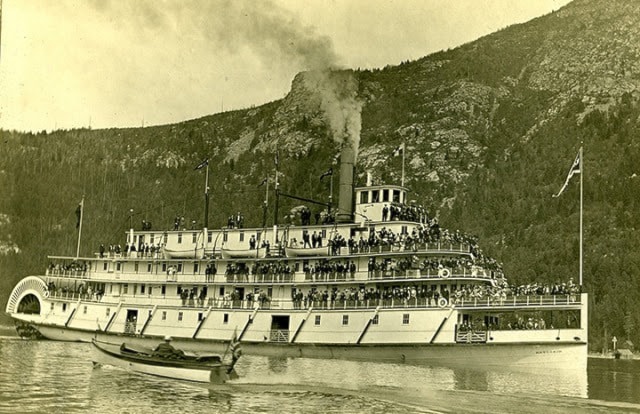Several comments, corrections, and clarifications came in following the Star’s series on the centennial of the SS Nasookin’s launch.
First, Kaslo’s Mark Mealing notes the sternwheeler’s name probably was derived from the Ktunaxa word for chief. It was transcribed in anthropologist Franz Boas’ 1918 work Kutenai Tales as naso’ukue•n.
Second, retired Nelson fire chief Harry Sommerville called to say he has the ship’s compass and a rack from one of its staterooms.
Third, Gray Creek’s Tom Lymbery clarified the sequence of the ship’s conversion to a ferry, thanks to a scrapbook of newspaper clippings compiled by Earle Cutler.
The province bought the boat outright in January 1933, and remodelled it that July to carry heavy buses. In May 1934, A.H. Green of Nelson (the same guy who built the Capitol Theatre) was awarded the contract to take the top deck off completely. This was done while the ferry was in service, with carpenters throwing cut off sections overboard. (The Gray Creek Historical Society has a couple of these pieces that came from Capt. Malcolm MacKinnon’s place in Procter, as well as two sheet metal bathtubs with fancy cast legs donated by Merv Coles, who owns the Nasookin’s pilothouse and forward observation deck.) The boat was, however, placed on the ways in Nelson to lower its wheelhouse and funnel.
Fourth, George Coletti, one of the original officers of Nelson’s sea cadet corps, wanted to stress they weren’t responsible for the Nasookin’s broken back. In the late 1940s, the group received a long-term lease from the federal government to moor the old ship roughly where the mall parking lot is today. They had great plans for the ship and were negotiating with the CPR to pipe steam to it for heat.
But when the city realized the ship was on top of one of their sewer outfalls, they asked it be moved beside the city wharf. Coletti and another officer rowed around the site and found it unsuitable due to concrete foundations in the water from an old sawmill.
“We went back to the city and said there was no way the ship could sit there,” he recalls. “They said don’t worry, we’ve taken soundings and found when the water goes down, it will settle without any problem.”
But during low water of 1949, the hull settled on the foundation, listed, and sank in shallow water. Hence a lawsuit against the city, which was settled for $1,000. The money paid rent on whatever basements the cadets used instead. But ever since, Coletti has been trying to dispel the myth the cadets were to blame.
“I’ve always been incensed by that,” he says. “It was a horrible loss for the sea cadets, the city, everyone involved.”
Finally, we might sheepishly admit that the picture of the Nasookin’s maiden voyage that appeared on the Star’s front page was actually taken in May 1913, not 2013.
